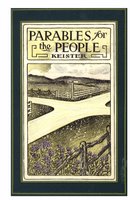Parables for the People
 Several weeks ago, I contacted the Library at Lebanon Valley College and asked if they had a copy of The Shining Pathway by Rev. Lawrence Keister, Past President, thinking that they might like to have my copy. I received an answer from the archivist, thanking me for the offer but saying that they did have a copy, more than one, and would I like a copy of Rev. Keister's book, "Parables for the People." It arrived yesterday and I have explored it and managed to read quite a bit of it already. As in the case of "The Shining Pathway", I will be sharing exerpts from this book from time to time.
Several weeks ago, I contacted the Library at Lebanon Valley College and asked if they had a copy of The Shining Pathway by Rev. Lawrence Keister, Past President, thinking that they might like to have my copy. I received an answer from the archivist, thanking me for the offer but saying that they did have a copy, more than one, and would I like a copy of Rev. Keister's book, "Parables for the People." It arrived yesterday and I have explored it and managed to read quite a bit of it already. As in the case of "The Shining Pathway", I will be sharing exerpts from this book from time to time. Here's an exerpt, from the introduction:
His (Christ's) disciples are commanded to claim and receive the Spirit of God as the only means by which they can have pure motives, right methods, and true manhood. Henceforth life and death are alike to them in this respect, that both are accepted as unto the Lord. In silence and in speech they should never step off this basis and sink to the level of the irreligious and the worldly. They see God in nature and can speak in parables. They see Him in providence and discover the principles of divine action. They see Him in the Christ and are satisfied with this revelation of the Person of Deity. The visible and the invisible are no longer held apart in their thoughts as mutually destructive, but are brought together to form the complete whole in which the Christian lives. In this entire realm Christ has manifested Himself as God and also as man, and hence the Christian is to occupy both according to the prayer and promise, "I will that where I am, there my disciples may be also." While each Christian can and must form his own views, he is not at liberty to step outside of Christ's world or try to limit himself to either part alone. He belongs to both the visible and the invisible, and has publicly confessed this article of his creed. He must be judged by this standard. His is the life of faith, being named from the principle element. He shows his faith by his workds, ministering to mankind and glorifying God in the highest place in his own heart, and thus prepares himself to glorify God in heaven, which is man's heaven also, now in spiritual fellowship and Christian hope, and then in personal presence and possession.

0 Comments:
Post a Comment
<< Home